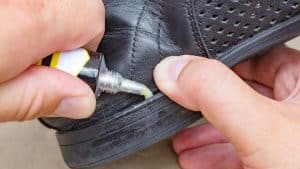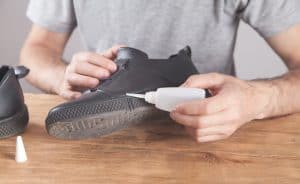- Heating with a hairdryer.
- Freezing bags of water inside.
- Filling with wet newspaper.
- Using a shoe stretcher.
Keep reading to learn more about each method - how to do it and how much you can stretch. Plus, we'll cover just how safe and comfortable plastic (or perspex) shoes really are. Finally, we'll teach you how to keep your shoes looking awesome.
![wo pairs of shoetree on the vintage background fired wood, How To Stretch Plastic Shoes [4 Must-Try Methods]](https://stylecheer.com/wp-content/uploads/2021/03/How-To-Stretch-Plastic-Shoes-4-Must-Try-Methods-683x1024.png)
This article may include affiliate links and elements that were carefully created by our team using advanced ai to help you envision the best style advice.
Can You Stretch Shoes One Size Up?
It is possible to gain an entire shoe size by stretching, although individual results will vary for each pair of shoes. As a general rule, plastic shoes aren't flexible enough to stretch more than half a size.
It's also worth mentioning that there are some risks - if your shoes are costly, you might be further ahead, letting a cobbler stretch them for you. At-home methods to stretch shoes can potentially weaken the glue and adhesive in the shoes, shortening their lifespan. There is also the potential for cracking or splitting.
These methods are recommended for stretching plastic shoes. These solutions can work for other materials, however. The most important thing is to be cautious before using any of these methods on leather shoes. Leather can discolor easily, and it also stretches with less effort - these methods may be TOO effective for leather and leave your shoes too big! Now let's get into the various stretching methods.
Use A Hair Dryer
Put on thick socks (or two, depending on how much stretching you need to do) and wear the shoes. It should fit very snuggly. Put the hairdryer on high and hold it a few inches away from the shoe. For 30 second intervals, direct the heat to where the most stretching is required. As the shoes heat up, you can wiggle and stretch to help them expand.
When you think you're ready, walk around for a while as the shoes cool. This will help break them in. Then, remove the socks and try them like normal. If they aren't quite right, repeat as needed.
Freeze Bags Of Water
Fill a sealable sandwich baggie (or more) partway with water. Remove extra air and seal, then insert the bag into the shoe. Ensure that the bag is pushed fully into the toe and fills the area that needs to be stretched. Make sure the bag is sealed fully and won't leak.
Put the shoes in the freezer overnight, letting the water freeze fully. If you want, put the shoes inside of another bag first. This will protect both the shoes and, further, protect the items in your freezer from your shoes. As the water freezes into ice, it will expand. This subsequently causes the shoes to stretch. Thaw and try on - if you need to, you can freeze additional times until you get the perfect fit.
Fill With Wet Newspaper
Make balls of newspaper, large enough to fill the shoe. Wet them, making sure that there's enough newspaper. Then, put them outside to dry in the sun. As the newspaper dries, it expands and pushes to expand the shoe as well.
How Do You Use A Plastic Shoe Stretcher?
You can buy a tool designed especially for stretching shoes. These can expand both the width and length of shoes. They also come with special inserts that will "spot stretch" by targeting specific areas on the shoe.
Start by inserting the toe block, making sure that it's in the front. Push the stretcher up toward the top of the shoe. At the same time, push the heel of the stretcher down carefully. When you're fully in the shoe, you are ready to stretch.
Lengthen the stretcher as needed so that the heel block is to the very back of the shoe. It must fill the whole shoe snugly, or stretching will not work - it doesn't matter if you're stretching for length or width.
Now, lengthen the stretcher as appropriate. Turn the handle to increase the width or length as appropriate. Once it's snug, increase it slowly a few more turns to stretch. Don't go too fast or stretch too far - take your time, or you might ruin your shoes. Leave the stretcher in for at least 8 hours to work. Try on and repeat if needed.
Click here to see this shoe stretcher on Amazon.
Are Plastic Shoes Bad For Your Feet?
Plastic, or perspex shoes, certainly come with limitations. To begin, plastic shoes have very little flexibility or give to them. As a result, even shoes that fit comfortably in the morning may feel tight by the afternoon. Feet naturally swell for a lot of reasons, and plastic shoes can't accommodate this.
Then, there's the breathability issue. Close-toe plastic shoes, in particular, can trap moisture and sweat. This can lead to bacterial or fungal growth. Even open-toe shoes can only let so much moisture out.
Lastly, plastic can be irritating to some people's skin. Plastic is a relatively common allergen when worn all day and can even lead to contact dermatitis. If you're determined to wear plastic shoes, be careful to pick the right time and place - they might be great for a short trip out, but not so great for a full day of sightseeing.
Are Perspex Shoes Comfortable?
Despite all of the reasons that perspex might not be very healthy for your feet, people who wear them seem to mostly agree that they don't feel uncomfortable. If your feet sweat a lot, you may not prefer them. Plastic shoes do trap heat and sweat, which can be bothersome to some people. But the general consensus? They aren't any more painful or uncomfortable than their counterparts in other materials.
How To Keep Feet From Sweating In Plastic Shoes?
There are two pretty simple solutions that can at least help fight back against sweaty plastic shoes. The first and most obvious? Put clear antiperspirant on your feet first. After all, it's made to fight sweat - literally. Feet might be an unusual place for it, but it can still get the job done.
The second might be a bit more surprising. Spray your shoes with WD-40. After all, WD-40 is used (among other reasons) to waterproof shoes in the winter - why not let it waterproof your shoes against sweat?
How To Clean Perspex Shoes?
All that sweating can leave your shoes pretty nasty. Plastic shoes can start to yellow or look hazy. And that's not to mention the germs, fungus, or bacteria that might be growing inside. So how do you polish them to look good as new?
It's pretty simple, and all you'll need is Lysol wipes! Other recommendations are out there, such as vinegar or dish soap. While these may work for some shoes, they don't seem to have consistent results. Lysol wipes are the fastest, most effective method. Watch the video for more information.
In Closing
Plastic shoes can be stretched to obtain a better, more comfortable fit. Methods include using a hairdryer to heat the shoes, placing bags of water inside and freezing, inserting wet newspaper, or using a shoe stretching tool. However, plastic shoes are not very flexible and will only be able to stretch so far. Typically, plastic shoes can stretch up to half a size larger, though it is possible sometimes to stretch further. Results will vary with each pair of shoes.
Use any of these methods at your own risk, as they may have unintended results. They may break down or damage the glues or adhesives in the shoes, and as a result, shorten their lifespan. They can also cause your shoes to crack or split. If your shoes are expensive, the safest bet is to let a professional cobbler do the stretching.
Enjoyed this article? Try:




